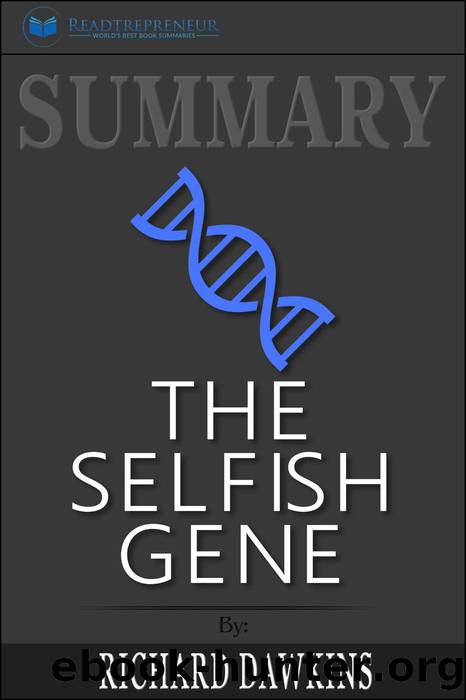Summary of the Selfish Gene by Readtrepreneur Publishing

Author:Readtrepreneur Publishing
Language: eng
Format: epub
Tags: the selfish gene 40th anniversary edition richard, blind watchmaker evidence evolution reveals, universe without design god delusion extended, phenotype long reach gene oxford landmark science, ancestor's tale pilgrimage dawn evolution how mind, new google e non fiction guide grit of for kids, summary 2019 2020 top book books paperback online
Publisher: Readtrepreneur Publishing
Published: 2018-06-28T00:00:00+00:00
Chapter 6. Genesmanship
The selfish gene is a single physical bit of DNA that is distributed throughout the living world. Itâs trying to efficiently replicate itself in the gene pool by assisting to program the body it finds itself in. Itâs also quite possible that a selfish gene can help replicas of itself that are living and located in other organisms or bodies. In the surface, this looks like a classic example of individual altruism but itâs actually brought about by gene selfishness.
Dawkins illustrates this idea with the gene for being an albino man. The albino gene is distributed in a lot of individuals. In theory, itâs possible that the albino gene helps ensure its survival by programming its hosts to treat other albino bodies altruistically. The albino gene can also become content if an albino body dies, provided that the death of the body helps other albino bodies survive and prosper. This raises the question: are albinos expected to always act altruistically towards each other? According to Dawkins, the most viable answer is probably no. However, there are quite plausible ways in which genes might recognize their copies in other survival machines. This idea has been promulgated by the likes of W.D. Hamilton, J.B.S. Haldane, and R.A. Fisher. Hamilton, in particular, has written two papers in the 1960s about such topics.
Genes for kin-altruism are further discussed by Dawkins, saying that there are levels on how genes treat their survival machines altruistically. For example, a gene for saving five cousins in an almost suicidal manner will not prosper in the gene pool compared to a gene for saving five brothers or ten first cousins. For a suicidal altruistic gene to be successful, it must meet the minimum requirement of saving more than two siblings or more than four half-brothers and sisters.
Although the theory of kin selection among genes has a lot of criticisms, Dawkins is adamant that itâs true, given the numerous examples of it in the world. He states that parental care and child-protection acts in the animal world are all fine examples of the kin-selection principle. These include acts associated with milk-secreting glands, bodily organs, and pouches, among others.
Download
This site does not store any files on its server. We only index and link to content provided by other sites. Please contact the content providers to delete copyright contents if any and email us, we'll remove relevant links or contents immediately.
The Science of Philip Pullman's His Dark Materials by Mary Gribbin(212)
Harry Potter and the Sorcerer's Stone: SparkNotes Literature Guide by SparkNotes(195)
Flowers in the Gutter by K. R. Gaddy(187)
Summary of the Selfish Gene by Readtrepreneur Publishing(163)
Super Simple Chemistry by D.K. Publishing(146)
JavaScript Coding for Teens: A Beginner's Guide to Developing Websites and Games by Yueh Andrew(135)
Cracking the AP Economics Macro & Micro Exams, 2017 Edition by Princeton Review(132)
Solutions for a Cleaner, Greener Planet: Environmental Chemistry by Marc Zimmer(130)
The Science of Fashion by Julie Danneberg;(125)
Key Immigration Laws by Kathryn Ohnaka(124)
The Python Audio Cookbook;Recipes for Audio Scripting with Python by Alexandros Drymonitis(122)
Dark days in Salem: the witchcraft trials by Deborah Kent(114)
Cracking the AP Psychology Exam, 2017 Edition by Princeton Review(110)
Fake News and Propaganda by Fiona Young-Brown(110)
Braiding Sweetgrass for Young Adults by Robin Wall Kimmerer(109)
Archaeologists! by Clifford Thompson(105)
Reverse Engineering For Everyone! by mytechnotalent(102)
DNA and RNA by Jenny Chen(97)
The Basics of Biochemistry by Kyle Kirkland(97)
